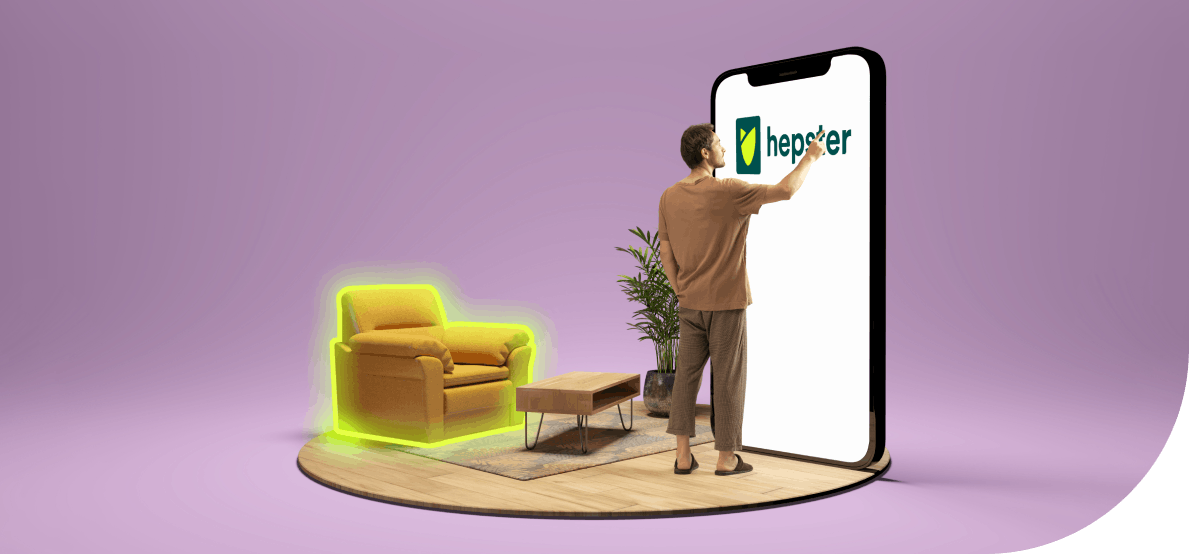How the furniture industry can benefit from integrated insurance solutions

A difficult environment, but also one rich in opportunities
Customers' needs have changed significantly in 2022. Furniture will still be needed in the future. However, due to high inflation, many households are setting other priorities so that they can continue to afford the prices of food and energy, for example. The result is a noticeable decline in demand, which poses fundamental challenges for brands.
The furniture industry was able to post a healthy increase in sales of eight per cent for 2022. Given this growth, however, the sometimes enormous price jumps, especially in the low-priced furniture segment, must be taken into consideration. If one focuses on the declining sales volume, the market shows itself in a far less friendly light. Buyers with higher incomes are less constrained by the price increases. This is reflected in the comparatively stable demand for furniture in the medium- and high-priced segment.
This finding suggests that even in a difficult market environment, it is important to continue investing rather than cutting back on budgets. According to a HubSpot study, for example, 93 per cent of customers are willing to buy again from a company that offers excellent customer service. Similar findings come from a report by Qualtrics XM Institute, according to which customers are 38 per cent more likely to recommend a company whose service they have rated "good".
In times when a furniture purchase easily takes on the dimension of a mammoth financial test for many consumers, insurance plays a special role. Medium- and high-priced furniture in particular often cannot be easily replaced in the event of damage. If you offer your customers the additional service of a furniture insurance policy, you meet the widespread desire for risk minimisation. Many consumers have a certain respect for expensive pieces of furniture. However, smart furniture that quickly loses its functions in the event of damage is also a cause for concern. An integrated insurance solution counters these concerns and thus strengthens customer loyalty to the company. Customers who feel secure are also more willing to recommend a provider to others.
Between stationary trade and e-commerce
The total turnover of the furniture industry in Germany in 2022 was around 35.3 billion euros. Of this, about 8.7 billion euros were accounted for by online trade. According to a Statista forecast, e-commerce with furniture could already reach a volume of 10.5 billion euros in 2025. In light of this development, it is astonishing how step-motherly many retailers still treat e-commerce.
More and more online shops have indeed sprung up in recent years. However many of them only serve the purpose of making potential customers want to visit their showrooms. There are still many furniture suppliers who do not have their online shop. But even among those who are represented online, the existing functions are often only sparsely developed. The technologies for high-quality digital customer advice are available, for example via app or augmented reality, but are still used very cautiously.
It is true that many customers still attach great importance to first seeing a piece of furniture on-site. However, focusing completely on stationary retail could prove to be a fatal mistake for many retailers. Online features such as visualisation tools allow customers to view furniture in different sizes, rotate it or examine it in different colours and styles with just a few clicks. WebAR can even be used to answer the question of how the sofa or table would look in one's own home.
What the omnichannel approach does for contemporary customer contact
Today, customers are no longer only interested in buying a good product at a good price. An appealing customer experience is increasingly coming to the fore. Furniture companies should follow this development closely. It will likely contribute to the omnichannel approach becoming even more important in the coming years. In practice, it means for companies to get in touch with their customers through a variety of channels to promote, sell and provide help for their products. Whether through search engines, blogs, their website, chatbots, apps or social media: Thanks to the interaction of the different channels, furniture suppliers have the chance to address their customers individually at every point of the customer journey.
An omnichannel strategy helps to noticeably improve the quality of customer communication and strengthen customer loyalty. The diverse interactions also generate a lot of data that can be easily collected and evaluated, for example with special analysis tools. The data allows us to get to know our customers better and better. What are customers looking for? What do they value? What needs do they have? The more precisely these questions can be answered, the more individualised the customer approach can be.
Social media gives furniture companies new opportunities to interact with customers. After all, they enable the target group to discover and discuss brands and products collectively. Therefore, they can be considered natural extensions of furniture webshops. Above all, the provision of relevant information plays a key role. Of course, this also applies to the websites themselves. It is still easy to distinguish oneself from competitors who only equip their online presence with meagre information. How about, for example, informing the customer about the live inventory of the local shop and in this way encouraging them to drop by?
For an effective marketing strategy, it is crucial to focus on providing the customer with the most positive customer experience possible at every touchpoint. This motivates them to move on to the next point in the customer journey. Being able to provide them with an individualised insurance offer can add another exciting element to the customer journey.
You may wonder whether integrating such an insurance solution is compatible with your current budget. Fortunately, furniture insurance does not incur any additional costs for you, e.g. for integration. On the contrary: thanks to a smart commission model, you have the chance to earn money by taking out insurance. Integrated insurance services can therefore be counted as cross-selling and work for both stationary trade and e-commerce businesses.
Megatrend sustainability
Many forecasts suggest that the trend towards sustainability will continue to grow in the coming years and thus become an increasingly important criterion for customers. Sustainability has also long been a major topic within the furniture industry. According to a PwC study, three-quarters of buyers attach importance to "green" furniture. The times when only a minority took sustainable aspects into account when making a purchase decision have long been a thing of the past.
Furniture from renewable raw materials, such as wood or bamboo, is very popular. In addition to the material, however, pollutants are also increasingly coming into focus. For many consumers, it is an absolute must that lacquers and glazes are harmless to health. By far the largest part of a piece of furniture's CO₂ footprint can be traced back to the supply chain. Regional manufacturers and suppliers in particular are benefiting from the growing awareness of this issue. A sustainable piece of furniture is of course also characterised by longevity, as it contributes to lower resource consumption. Many customers are also increasingly attaching importance to social responsibility, which can be seen, for example, in good working conditions and fair wages in production.
The term circular economy is also appearing more and more frequently in the discussion. This form of value creation pursues the goal of using all materials in such a way that they remain in the economic cycle wherever possible. The approach can be summed up as follows: resources should no longer be consumed but should be used in every stage of the value chain. This also applies to the time after the actual use of the piece of furniture. Furniture companies can contribute to strengthening the Circular Economy by increasingly including repairs as an option in their claims settlement. A repair requires fewer resources than the procurement of a replacement piece of furniture.
This option of insuring furniture is more than just a sign against the throwaway society. It has the potential to increase customer confidence, strengthen one's brand and differentiate oneself from competitors. Last but not least, a sustainability-oriented insurance solution can increase the upselling potential of a furniture company. In principle, consumers are willing to spend more on furniture if the supplier credibly shares their demands on sustainability. An environmentally conscious corporate philosophy opens up many possibilities for the company's marketing activities, for example in social media.
Sources
- https://de.statista.com/outlook/cmo/moebel/deutschland#umsatz
- https://blog.hubspot.com/service/customer-acquisition-study
- https://success.qualtrics.com/rs/542-FMF-412/images/ROI%20of%20customer%20experience%202020.pdf
- https://www.cadesignform.com/de/blog/trends-moebelbranche
- https://cdn2.hubspot.net/hubfs/2771217/Content/2018%20Customer%20Service%20Expectations%20Gladly.pdf
- https://www.welt.de/wirtschaft/article243914847/Moebel-Branchen-Plus-beim-Umsatz-doch-der-Erfolg-truegt.html
- https://www.helpscout.com/75-customer-service-facts-quotes-statistics/
Experts at your side
Are you thinking about offering your customers integrated insurance cover, for example, a furniture protection policy? Our sales team will be happy to advise you and help you with the appropriate insurance services and models.


